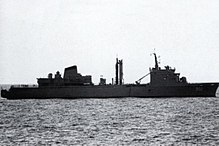
HMAS Success was a Durance-class multi-product replenishment oiler that previously served in the Royal Australian Navy (RAN). Built by Cockatoo Docks & Engineering Company in Sydney, Australia, during the 1980s, she is the only ship of the class to be constructed outside France, and the only one to not originally serve in the Marine Nationale. The ship was part of the Australian contribution to the 1991 Gulf War, and was deployed to East Timor in response to incidents in 1999 and 2006. The ship was fitted with a double hull during the first half of 2011, to meet International Maritime Organization standards.
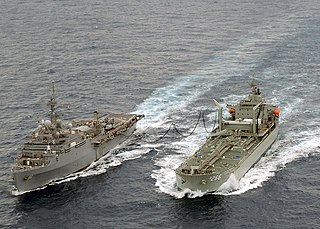
A replenishment oiler or replenishment tanker is a naval auxiliary ship with fuel tanks and dry cargo holds which can supply both fuel and dry stores during underway replenishment (UNREP) at sea. Many countries have used replenishment oilers.
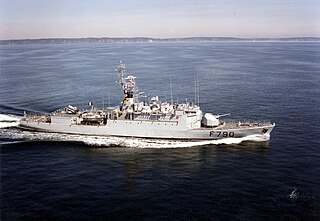
The D'Estienne d'Orves-class avisos, also known as the A69 type avisos, is a class of avisos, comparable in size to a light corvette, mainly designed for coastal anti-submarine defence, but are also available for high sea escort missions. Built on a simple and robust design, they have an economical and reliable propulsion system which allows them to be used for overseas presence missions. They were initially intended for use by the French Navy, but have been ordered by the South African Navy, Argentinian Navy and Turkish Navy.

The Foudre-class landing platform dock is a class of landing platform docks designed and constructed for the French Navy. Designated Transport de Chalands de Débarquement, they were intended to replace the ageing Ouragan class and the construction of four vessels was planned. Only two were built and the remaining two were instead reordered as Mistral-class amphibious assault ships. The two ships of the Foudre class, Foudre and Siroco, operated with the French Navy between 1990 and 2014. Replaced by the Mistrals, in 2011 Foudre was sold to the Chilean Navy and Siroco was sold to the Brazilian Navy in 2015.
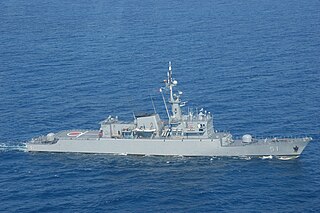
The Almirante Padilla-class frigates is a series of frigates operated by the Colombian Navy. The designation of this class is Type FS 1500 and there are four ships in service. The ships were built by Howaldtswerke-Deutsche Werft (HDW) at Kiel, West Germany in the 1980s, with the first vessel commissioning in 1983 and the last in 1984. The frigates have undergone significant modification over their careers with the 2012 Orion Program Upgrade significantly modernising the vessels. Two similar ships operate as the Kasturi-class corvettes in the Royal Malaysian Navy.

Newport-class tank landing ships were an improved class of tank landing ship (LST) designed for and employed by the United States Navy from 1969 to 2002. The ships were intended to provide substantial advantages over their World War II-era predecessors. Larger and faster than any previous LST design, they carried a ramp over the bow that allowed them to surpass 20 knots, a goal of the United States amphibious forces. 27 were planned of which twenty were completed, the high number due to the demands of US force projection estimates. However, the arrival of the air-cushioned landing craft which allowed for over-the-horizon attacks made the class obsolete in the eyes of the United States Navy. Placed in reserve, twelve were eventually sold to foreign navies, while the remaining eight have since been decommissioned.

The Type 704 Rhön-class tankers are a series of replenishment oilers used by the German Navy to provide underway replenishment for its ships at sea. The two vessels in the class, Rhön and Spessart, were originally constructed for Libya by Kröger Shipyard in Rendsburg, West Germany as bulk acid carriers. They were acquired by the West German Navy in 1976 for conversion and entered service in 1977. The two ships are crewed by civilians. In 2019 it was announced by the German Navy that the ships are planned to be replaced in 2024.

ARA Patagonia (B-1) is a multi-product replenishment oiler of the Durance class in service in the Argentine Navy. She was the lead ship of her class serving in the French Navy as Durance from 1977 to 1999. In French service, the ship served with the Force d'action navale. In Argentine service the vessel is used in multi-national naval exercises and supplies the Antarctic missions operating from Ushuaia. In 2017, Patagonia was used to search for the missing submarine ARA San Juan.

The Chamsuri class are patrol boats originally constructed for and operated by the Republic of Korea Navy. They first entered service in 1979, and they have since seen service with five other navies, of which the Philippine Navy is currently the largest import user. These boats were built by the Korea Tacoma, and Korea SB & Eng. Masan shipyards. In Korea, the Chamsuri-class boats are being retired and replaced by Gumdoksuri-class patrol vessels.

The Churruca class was a Spanish destroyer class built for the Spanish Navy based on a British design. Eighteen ships were built, with two being sold to Argentina and commonly referred to as the Cervantes class. The last two members of the class are sometimes referred to as a separate class, the Alava class.
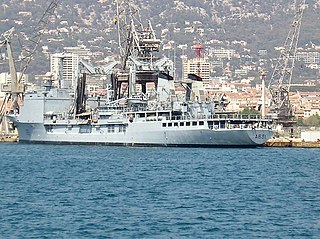
The French tanker Somme is a Durance-class command and replenishment tanker of the French Navy. In addition to its primary duty as a fleet tanker, Somme is configured as a flagship and has served as such in the Indian Ocean. The vessel was constructed at La Seyne, France beginning in 1985 and entered service in 1990. In October 2009, the ship was mistakenly attacked by pirates off the coast of Somalia. The attack was repelled and the pirates captured.

The Vulcano class is a class of replenishment oiler used by the Italian Navy, with lead ship Vulcano of the class entered service on 12 March 2021. The ships are designed to support fleet operations with fuel and dry stores and expected to replace the Stromboli class, another class of replenishment oiler from the Navy. Vulcano was financed under the 2014 Naval Law, for €346 million, then increased to €374.6 million, when the length was extended by 12 metres (39 ft). A second ship Atlante was ordered in January 2022 for projected delivery in 2025. The Navy also had an option for a third ship of the class. However, under the Italian MoD’s Multi-Year Defence Planning Document for the 2023-2025 timeframe, a fourth ship was added to the program.

The Boraida class is a ship class of two replenishment oilers built for the Royal Saudi Navy by CN la Ciotat at Marseille, France. It is a modified version of the French Durance-class replenishment ship. They were constructed in 1983 and entered service in 1984. The two ships are based at Jeddah, Saudi Arabia.

The Akar class is a series of two replenishment oilers and fleet support ships, designed and built for service in the Turkish Navy. The lead ship of the class, TCG Akar, was constructed in 1982–1983 and entered service in 1987. The second ship, TCG Yarbay Kudret Güngör, was constructed in 1993–1994 and entered service in 1995. Both ships were constructed in Turkey, though Yarbay Kudret Güngör was the first ship built for the Turkish Navy by a private shipyard. Both vessels remain in service.
ARA Punta Médanos (B-18) was an auxiliary ship of the Argentine Navy, a tanker built at the Swan, Hunter & Wigham Richardson shipyard, Wallsend, in 1950. While in naval service she made several commercial trips supplementing the YPF tanker fleet, and supported the high seas fleet; in this capacity Punta Médanos participated in the Falklands War in 1982. She was decommissioned in 1984 and sold for scrapping. The vessel was named after the coastal feature of Punta Médanos, Argentina, and was the first Argentine naval ship with this name.
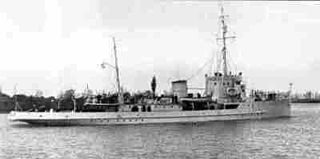
ARA Fournier (M-5) was a Bouchard-class minesweeper of the Argentine Navy. She was in service from 1940 until her sinking in 1949.
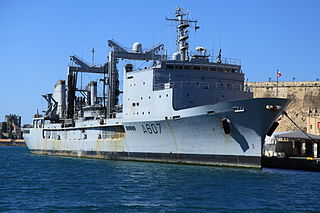
Meuse is a Durance-class replenishment oiler of the French Navy. Constructed by the Brest Arsenal in Brest, France, the vessel was launched on 2 December 1978 and entered service in 1980. The tanker served on several overseas operations, often operating with France's aircraft carriers in a support role. Meuse was taken out of service on 16 December 2015.

Var was a Durance-class command and replenishment tanker of the French Navy. In addition to its primary duty as a fleet tanker, Var was configured as a flagship and served as such in the Indian Ocean. The ship was laid down on 8 May 1979 by Brest Arsenal at their yard in Brest, France. She was launched on 1 June 1981, commissioned on 29 January 1983 and assigned to the Force d'action navale. Var took part in several multi-national operations. The tanker was decommissioned on 1 July 2021.

Marne was a Durance-class command and replenishment tanker of the French Navy. In addition to its primary duty as a fleet tanker, Marne was configured as a flagship and served as such in the Indian Ocean.

The bâtiments ravitailleurs de forces, or BRF, are a class of future fleet tankers that are to replace the Durance-class units in French Navy service. Until January 2019, the programme was known as Flotte logistique. First ship of the class completed the first stage of her sea trials in January 2023 and was formally delivered to the French Navy in July to continue her sea trials. The ships are part of the Vulcano-class logistic support ship programme.




